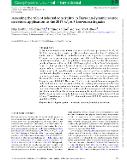Assessing the role of selected constraints in Bayesian dynamic source inversion: application to the 2017 M-w 6.3 Lesvos earthquake

Datum vydání
2022Publikováno v
Geophysical Journal InternationalRočník / Číslo vydání
228 (1)ISBN / ISSN
ISSN: 0956-540XMetadata
Zobrazit celý záznamKolekce
Tato publikace má vydavatelskou verzi s DOI 10.1093/gji/ggab359
Abstrakt
A dynamic finite-fault source inversion for stress and frictional parameters of the M-w 6.3 2017 Lesvos earthquake is carried out. The main shock occurred on June 12, offshore the southeastern coast of the Greek island of Lesvos in the north Aegean Sea. It caused 1 fatality, 15 injuries, and extensive damage to the southern part of the island. Dynamic rupture evolution is modelled on an elliptic patch, using the linear slip-weakening friction law. The inversion is posed as a Bayesian problem and the Parallel Tempering Markov Chain Monte Carlo algorithm is used to obtain posterior probability distributions by updating the prior distribution with progressively more constraints. To calculate the first posterior distribution, only the constraint that the model should expand beyond the nucleation patch is used. Then, we add the constraint that the model should reach a moment magnitude similar to that obtained from our centroid moment tensor inversion. For the final posterior distribution, 15 acceleration records from Greek and Turkish strong motion networks at near regional distances (approximate to 30-150 km) in the frequency range of 0.05-0.15 Hz are used. The three posterior distributions are compared to understand how much each constraint contributes to resolving different quantities. The most probable values and uncertainties of individual parameters are also calculated, along with their mutual trade-offs. The features best determined by seismograms in the final posterior distribution include the position of the nucleation region, the mean direction of rupture (towards WNW), the mean rupture speed (with 68 per cent of the distribution lying between 1.4 and 2.6 kms(-1)), radiated energy (12-65 TJ), radiation efficiency (0.09-0.38) and the mean stress drop (2.2-6.5 MPa).
Klíčová slova
Earthquake dynamics, Waveform inversion, Probability distributions
Trvalý odkaz
https://hdl.handle.net/20.500.14178/1667Licence
This article has been accepted for publication in Geophysical Journal International©: 2021 Filip Kostka, Jiří Zahradník, Efthimios Sokos and František Gallovič. Published by Oxford University Press on behalf of the Royal Astronomical Society. All rights reserved






